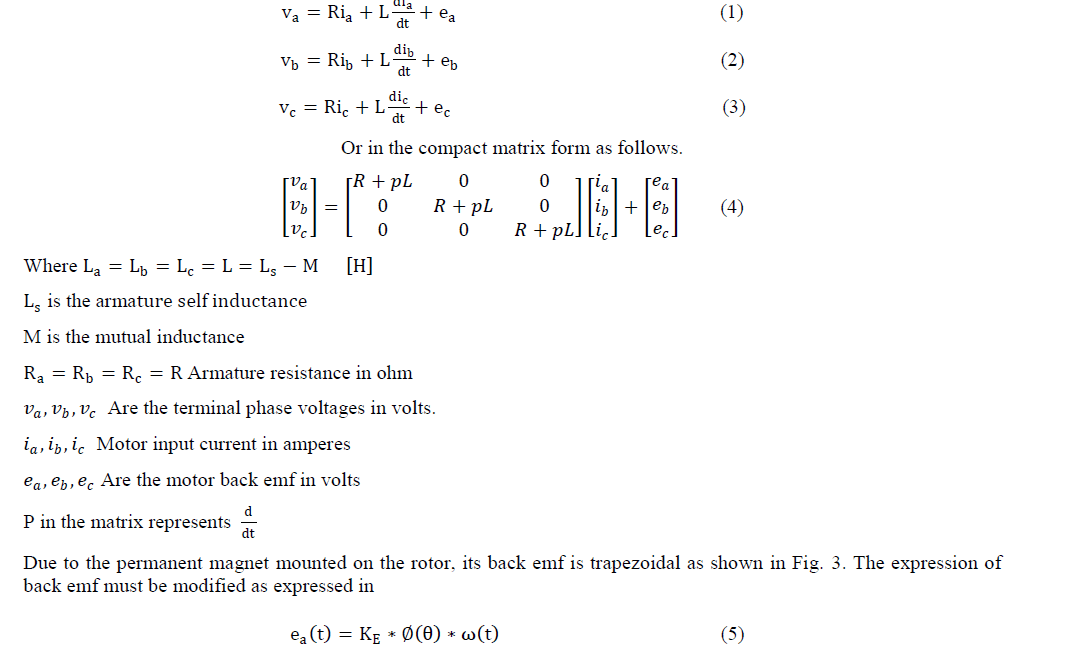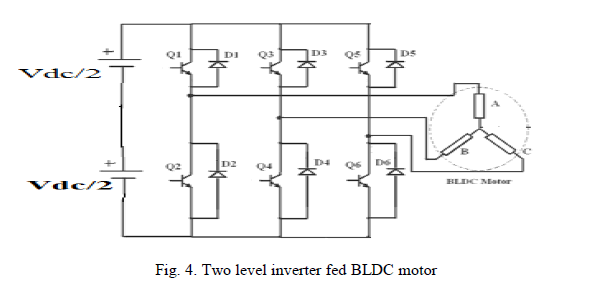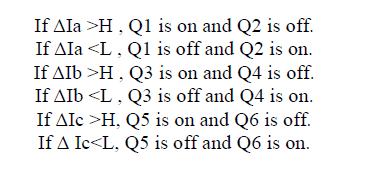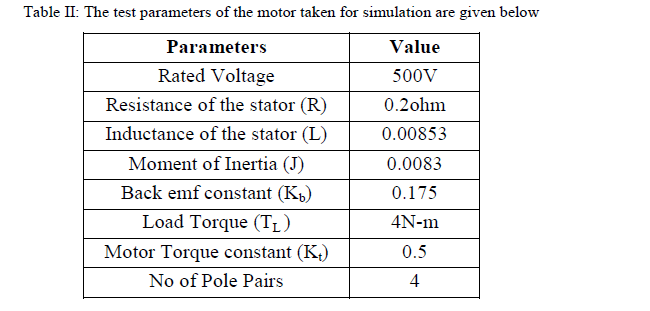Keywords
|
| Speed controller, feedback loop, Brushless dc (BLDC) motor drive. |
INTRODUCTION
|
| Using of Permanent Magnet in electrical machines have so many benefits and advantages then electromagnetic excitation machines these are zero excitation losses result in high efficiency, simple construction, low cost less maintenance and high torque or high output power per unit volume . Due to high power to weight ratio, high torque, good dynamic control for variable speed applications, absence of brushes and commutator make Brushless dc (BLDC) motor, best choice for high performance applications. Due to the absence of brushes and commutator there is no problem of mechanical wear of the moving parts [2], [3]. As well, better heat dissipation property and ability to operate at high speeds [4] make them superior to the conventional dc machine. However, the BLDC motor constitutes a more difficult problem than its brushed counterpart in terms of modelling and control system design due to its multi-input nature and coupled nonlinear dynamics. Due to the simplicity in their control, Permanent-magnet brushless dc motors are more accepted used in high-performance applications. In many of these applications, the production of ripple-free torque is of primary concern. There are three main sources of torque ripple production in BLDCMs: cogging torque, reluctance torque, and mutual torque. Cogging torque is created by the stator slots interacting with the rotor magnetic field and is independent of stator current excitation. Reluctance torque is caused by the variation in phase inductance with respect to position. Mutual torque is created by the mutual coupling between the stator winding current and rotor magnetic field. In general, surface-mounted magnets are used in many high-performance BLDCM’s. Because the permeability of the magnet material is nearly equal to that of air, the effective air gap is enlarged by the magnet. This fact ensures minimum armature effect on the rotor field from the stator currents. If a BLDCM is designed with low saliency and either the stator slots or rotor magnets are skewed by one slot pitch, the effects of the first two torque components can be greatly reduced. Therefore, if the waveforms of the phase back EMF and phase current are perfectly matched, torque ripple is minimized and the mutual torque component is maximized. In this paper finally closed loop speed control is done by using PI controller and hysteresis current controller loop is added with speed feedback loop and it is observed that there is a reduction in the current ripple hence torque ripple are minimized. |
MODELLING OF DRIVE SYSTEM
|
 |
A. Modeling of BLDC Motor
|
| Modeling of a BLDC motor can be developed in the similar manner as a three phase synchronous machine. Since its rotor is mounted with a permanent magnet, some dynamic characteristics are different. Flux linkage from the rotor is dependent upon the magnet. Therefore, saturation of magnetic flux linkage is typical for this kind of motors. As any typical three phase motors, one structure of the BLDC motor is fed by a three phase voltage source as shown in Fig. 2. The source is not necessary to be sinusoidal. Square wave or other wave- shape can be applied as long as the peak voltage is not exceeded the maximum voltage limit of the motor. Similarly, the model of the armature winding for the BLDC motor is expressed as follows. Following assumption are made. |
| 1. Motor is not saturated as it operated within the rated current |
| 2. There is no changes in the rotor reluctances with angle |
| 3 Three phases are balanced one. |
 |
 |
| Where KE is the back emf constant and ω is the mechanical speed of the rotor. |
 Fig. 2 BLDC Motor Control System Fig. 2 BLDC Motor Control System |
| The permanent magnet also influences produced torques due to the trapezoidal flux linkage. Given that KT is the torque constant. The produced torques |
 |
 Fig.3 BLDC Motor back emf and the motor phase currents Fig.3 BLDC Motor back emf and the motor phase currents |
| With the Newton’s second law of motion, the angular motion of the rotor can be written as follows. |
 |
| Where TL load torque in N-m |
| J rotor inertia in [kgm2] |
| B damping constant |
B. Closed-Loop Controller
|
| The BLDC motor is fed from a three phase two level inverter. The PWM gating signals for firing the power semiconductor devices in the inverter is injected from a hysteresis current controller block, which is required to maintain the current constant within the 600 interval of one electrical revolution of the rotor. It regulates the actual current within the hysteresis band around the reference currents. The reference currents are generated by a reference current generator depending upon the steady state operating mode. The reference currents are of quasi square wave in shape .The magnitude of the reference current is calculated from the reference torque. The reference torque is obtained by limiting the output of the PI controller. Speed error signal i.e. the difference between the reference speed and actual speed of the motor is given to the PI controller which gives the reference torque information. Due to the presence of re outer speed feedback loop the motor will drive at reference speed which is nothing but the closed loop control drive system. |
C. Inverter Modeling
|
| Fig. 4 Shows the two level inverter which supplies the input voltage for the three phases of the BLDC motor. It consists of two power semiconductor devices on each phase leg. Firing of the pair power semiconductor devices is based on the hall sensors input. Three phases are commutated for every 60o. Synchronization between stator and rotor flux is achieved because sensors are the direct feed back of the rotor position,. The inverter is modeled using below equations (14), (15) and (16). |
 |
 |
D. Modeling of Hysteresis current Controller
|
| Fig.5 shows the the block diagram of hysteresis current controller which will generate the gating signals for inverter. The input currents, ia, ib, ic are measured and compared with the reference currents, ia*, Ib*, Ic*. The error is fed to a comparator with a prescribed hysteresis band. Switching of the power semiconductor devices (Q1 ON and Q2 OFF) occurs when the current attempts to exceed a set value corresponding to the desired current. The reverse switching (Q1 OFF and Q2 ON) occurs when the current attempts to become less than iaref . Hysteresis controller is simple to implement and produces a very good quality of waveform. . The drawback of this method is that the switching frequency does not remain constant but varies along different portions of the desired current. The switching pattern is given as: |
 |
 |
| Where ΔIa=Ia*-Ia and H, L are the upper and lower limits of hysteresis band. Thus, by regulating the current desired quasi-square waveforms can be obtained. |
E. Modeling of speed controller block
|
| Fig.6 shows the speed controller block diagram. In this PI controller is used as a speed controller. Speed error i.e. differences between reference speed and actual speed of the motor are the inputs signals to the speed PI controller. Kp and Ki values are determined by trial and error method for each set of speed. |
 |
SIMULATION RESULTS
|
| The proposed strategy of two level inverter fed BLDC motor Hysteresis current controller is analysed with and without Hysteresis current controller using MATLAB / SIMULINK for the validation of work and results are presented. |
I. Without Hysteresis current control loop
|
| Fig.7 Show the simulink block diagram of the closed loop operation of BLDC motor drive without hysteresis control. Fig 8 shows that dynamic behavior of the motor when speed reference is set at 3000 rpm. A current of 20 amps is observed at the time of starting, at t= 0.04 motor taking a current of 0.1 amps at no load. At t=0.1 second motor is developing a torque of 3Nm and having a steady state stators current of 4.5 amps. Motor speed reached to set value of speed with a very small dip. |
 |
 |
| Fig. 9 shows that a motor is developing a high torque of 20 Nm at the time of starting and develops a torque of 0.1 Nm at no load condition. At t=0.1 sec motor is developing a torque of 3Nm. Fig. 10 shows that the back emf developed by the motor is in trapezoidal shape |
 |
 |
II. With Hysteresis current control loop
|
| Fig.11 Show the simulink block diagram of the closed loop operation of BLDC motor drive with hysteresis control. Fig. 12 shows the Dynamics of the motor with hysteresis current controller. It is observing that magnitude of starting currents are very less compared with without hysteresis current controller, here the magnitude of starting current is 1.75amps at the time of starting. Fig. 13 shows that motor is developing nearly constant torque from no load to load at t=0.1 sec of 2Nm. |

Fig. 11 SIMULINK model of BLDC motor drive without Hysteresis current controller loop |
 |
 |
III. Comparison
|
| Fig. 14 shows the comparison between the magnitude of ripples variation in stator current with hysteresis current controller and without hysteresis current controller. It is observed that without hysteresis current controller the current ripples varies between ±1 amps, while with hysteresis current controller, the variation in the ripple is between ±0.2 amps. |
 |
 |
| Fig. 15 shows that the magnitude of torque ripples are less in hysteresis current controller when compared with without hysteresis current controller fed BLDC drive as current ripples decreases torque ripples are also minimized or reduced. |
IV. Motor speed Performance for intermittent loads
|
| Fig. 16 shows that dynamic behavior of the drive system with change in the reference speed .It is observed that the speed controller is capable of tracking the changes in the reference speed effectively and efficiently. |
 |
V. Performance of drive under Loaded Condition
|
| Fig. 17 shows the speed time characteristic of the drive for different load conditions. Reference speed is set to 3000 rpm, and motor is subjected to various loads conditions i.e. load torque is equal to 1Nm, 1.5Nm and 2Nm. The time taken to reach the set speed 3000 rpm increases with the increment in load to be met. Table I shows the rise time of the load to reach set speed. Table II shows the test parameters of the motor taken for simulation. |
 |
 |
 |
CONCLUSION
|
| Permanent-magnet brushless dc motors is more widely used in high-performance applications because of their higher efficiency, higher torque in low-speed range, high power density ,low maintenance and less noise than other motors. In this paper closed loop speed control of BLDC motor drive with hysteresis current controller loop is carried out and it is compared with without hysteresis current controller fed BLDC drive. Simulation results shows that current ripple and torque ripple are minimized which enhance the performance of the drive. The results show that the dynamic performance of the motor is quite satisfactory for various loading conditions. |
References
|
- R. Civilian, and D. Stupak, "Disk drive employing multi mode spindle drive system," US patent 5471353, Oct 3, 1995.
- G.H. Jang and M.G. Kim, “A Bipolar-Starting and Unipolar-Running Method to Drive an HDD Spindle Motor at High Speed with LargeStarting Torque,” IEEE Transactions on Magnetics, Vol. 41, no.2, pp. 750-755, Feb. 2005.
- E.Grochowski and R.F. Hyot,”Future trends in hard disk drives”,IEEE Tran. On Magnetics, vol.32, no.3, pp1850-1854, May 1996.
- J.D.Ede, ,Z.Q.Zhu and D.Howe,”Optimal split ratio control for high speed permanent magnet brushless DC motors”, in Proc.5thInt,Conf..Electrical Machines and Sytems’,vol.2,Aug 2001,pp 909-912
- S.X.Chen, M.A.Jabbar, O.D. Zhang and Z.J.Lie,”New Challenge: Electromagnetic design of BLDC motors for high speed fluid filmbearing spindles used in hard disk drives”,IEEE Trans. Magnetics ,vol32,no.5, pp3854-3856,Sep. 1996.
- T.Kenzo and S. Nagamori, Permanent Magnets and Brushless DC Motors, Tokyo,Japan,Sogo Electronics,1984.
- J.R.Hendershot and Miller,”Design of Brushless Permanent Magnet Motors, Oxford Univ. Press,1994
- S.W.Cameron.”Method and apparatus for starting a sensorless polyphase dc motors in dual coil mode and switching to single coil mode atspeed”, U.S.Patent 5455885,, Nov.28,1995
- T.Gopalaratnam and H.A.Toliyat, “A new topologyfor unipolar brushless dc motor drives”,. IEEE TransPower Electronics, vol.18, No.6, pp1397-1404, Nov.2003.
- Bhim Singh and Sanjeev Singh, “State of art on permanent magnet brushless Dc motor Drives”, Journal of Power Electronics”, vol.9 no.1 pp 1-17 Jan.2009.
|